Charles Nègre: Vincennes Imperial Asylum (1859)
 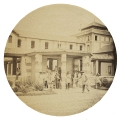 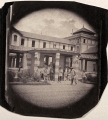 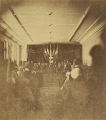  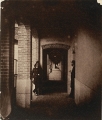
   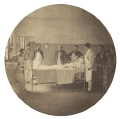  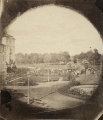
 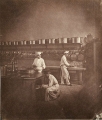    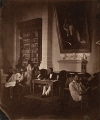
  
Contents Fragments Photographer Theme PhV Checklist
The following contemporary account was published on the "Imperial Asylum at Vincennes for Convalescent Workman" in The Medical News and Library in December 1860:
Imperial Asylum at Vincennes for Convalescent Workman. - The Moniteur Universal of the 9th of July contains an interesting account of the convalescent hospital, established by the Emperor of the French, in the neighbourhood of Paris, from which we extract the following particulars: —
The Asylum of Vincennes was founded by a decree of the 8th March, 1855, for the temporary reception, during their convalescence, of workmen who had received injuries or contracted diseases. The building having been finished, and the internal arrangements completed, the inauguration of the Imperial Asylum took place on the 31st of August, 1857. It has now been in operation for nearly three years.
Nearly forty acres of forest, belonging to the domains of the Crown, were consecrated to the Asylum, which is built upon an elevated terrace, freely exposed to the air from all quarters. Since the opening of the institution, up to the end of June 1860 (comprehending a period of two years and ten months), the number of convalescents admitted has amounted to 14,000. These convalescents belong to the following categories: 1st. Convalescents sent from the hospitals of Paris and the suburbs; 2d. Convalescents sent by the local charitable institutions of the city; 3. Convalescents from injuries received in the public works; 4th. Members of societies of workmen established for their mutual assistance; 5th. Workmen belonging to establishments, the directors of which have obtained from the Minister of the Interior authorization to send, on payment of a subscription, their convalescents to the Asylum, such as the railroads, gasworks, and some large private establishments; 6th. Workmen who have been treated at their own homes, and who have received from their medical attendant certificate of convalescence.
It is by the express orders of the Emperor that the Asylum is now open, without distinction, to every convalescent workman. There are at present 411 beds.
Two elegant vehicles are attached to the institution, and bear the imperial arms. One of these is of the same size as an ordinary omnibus, the other is somewhat smaller. Every day one or other of these vehicles, according to the number requiring removal, goes to the various hospitals to pick up the convalescents, and even goes to the residences of those who have been treated at their own homes. The same vehicles convey the inmates back to Paris when they leave the Asylum. The first time that the large omnibus stopped in front of the Hotel-Dieu a crowd of spectators speedily assembled; people asked one an other what could be the meaning of this elegant vehicle with the imperial arms in such a locality; but when the spectators saw the poor convalescents, weakened by disease, come out of the hospital and get into the omnibus, and when it was known that they were about to be conveyed to the Imperial Asylum, they broke out into hearty applause. How, in fact, could they help being affected on seeing the paternal cares of the Emperor lavished indiscriminately on all the workmen, on all the laborious classes?
The mean term of residence in the Asylum is 22 days. Thanks to the hygienic resources of the institution, the period of convalescence from fevers is comparatively short. The principle of the Asylum is that every convalescent shall remain in the Asylum until he is completely restored to health, or until his disease has been recognized as incurable.
Diet of the Institution. — The diet is regulated by the director, and by the superintending medical officer of the establishment. Care has been taken to fix the hours of the different meals, in conformity with the usual habits of the working classes. At half past seven in the morning the inmates get a bowl of soup. Breakfast is at half past ten, and consists of stewed meat and vegetables. Five o'clock is the dinner hour: this meal consists of soup, roast meat, and vegetables. Each convalescent receives daily about a pint of wine, and as much bread of the first quality as he desires. On the average, each inmate consumes daily about a pound and a half of bread. If necessary, a special dietary is prescribed in particular cases. The sum allotted for the food of each inmate is tenpence-halfpenny a day, not comprehending the general expenses of the establishment.
If the convalescents desire it, and if their strength permits, they are employed in various capacities about the establishment, under the direction of the gardener, the smith, the carpenter, etc. In this case, they receive a small sum of money and half a pint of wine in addition to the regular allowance Those of the inmates who do not work have various amusements provided for them, such as bowls, skittles, dominoes, etc.; cards are prohibited.
The library is open daily, and contains 4000 volumes, and illustrated newspapers. Most of the volumes have been presented by the booksellers of Paris. In general, about 50 readers may be found in the library at a time; on one occasion 96 were counted.
The conduct of all in the Asylum is exemplary. They submit without a word to the rules of the institution, are courteous to one another, take care of the furniture of the establishment and of the flowers in the garden, and keep their dormitories in a state of perfect cleanliness. Although not required, the majority of the inmates attend chapel on Sunday.
The staff of the establishment consists of a director, a treasurer, a medical superintendent, with three resident pupils; six Sisters of the Order of the Ladies of St. Augustine of Belgium; a secretary and five clerks; a storekeeper; four overseers; and at least forty persons in subordinate positions, such as cooks, grooms, gardeners, etc.
An infirmary is connected with the Asylum. During the year 185S, 1859, nearly 1100 patients, presenting various affections more or less severe, have been under treatment; during this time only 30 deaths occurred.
The anticipated expenses for the present year are between fourteen and fifteen thousand pounds.— Ed. Med. Journ., Sept. 1860.[1]
Footnotes
- Λ December, 1860, "Imperial Asylum at Vincennes for Convalescent Workman", The Medical News and Library, vol. XVIII, no. 216, pp. 184-185
Explore... | | Photographer | Theme | Images | www.luminous-lint.com
Creative Commons, Attribution-NonCommercial 4.0 International |
|

